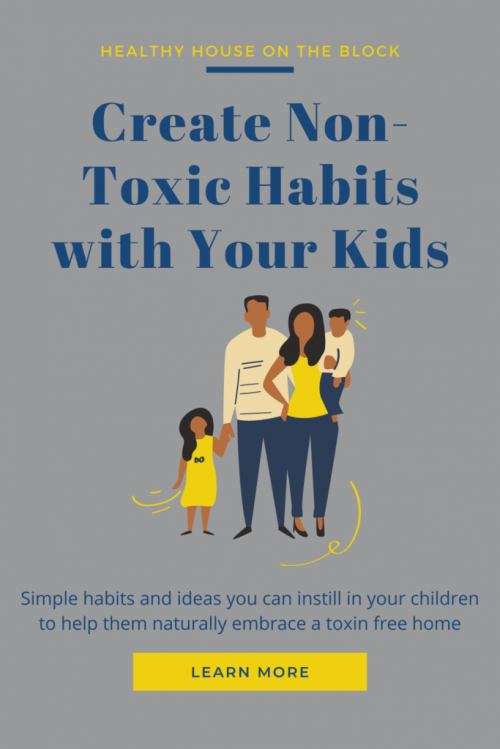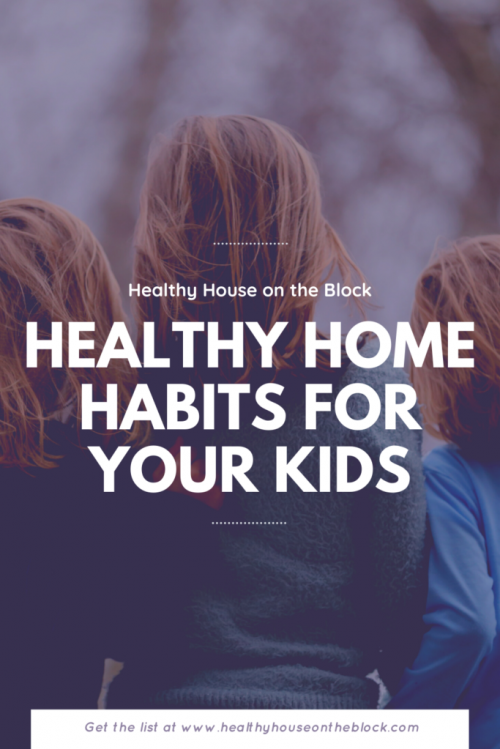Kids are just full of opinions, aren’t they? And to be honest, I absolutely love this — most of the time. I love watching my three kids form their own opinions based on their emerging personalities and preferences. However, this can get a little tricky when we’re talking about raising healthy kids in a mostly non toxic home. The majority of the world just isn’t on board with this lifestyle yet, and personally, I think it can make kids feel a little bit like an outsider.
Even if you’ve been consistent with your non toxic lifestyle from the beginning, at some point kids begin to recognize the differences in your home and their friends’ homes. And if you’re just starting out on your non toxic home journey, creating a space where healthy kids will thrive can be just as difficult. When you begin this journey after habits have been formed, you are not only implementing new habits, but also changing old patterns too.
But, I myself can tell you it’s completely doable to raise healthy kids in a non toxic home environment and do it all peacefully (mostly). The goal here is to create an indoor space that promotes health and wellness, but also create a space that everyone enjoys being in.
I’m no parenting expert and my family and I have our own struggles with keeping our house as low toxin as possible, but I have had some success with a few different tactics, habits and mindsets that I’m going to share with you.
TOXINS AND HEALTHY KIDS
Quite often I think we have this idea that kids are actually just mini adults. While it can seem like that, their bodies are actually quite different from ours and not completely developed to detoxify as ours might.
Our systems are fully developed and capable of filtering out toxins while protecting other organs from being affected. Children, on the other hand, have an undeveloped blood-brain barrier that allows many toxins to pass through before getting filtered out.
Children also have thinner and less dense skin and skeletal systems, meaning toxins can be absorbed at a more efficient rate in comparison to us as adults.
And if you have kids, you know that kids have much different hand-to-mouth habits in comparison to us as adults too. (Please tell me I’m not the only mom asking my kids to keep their hands off their faces and out of their mouths on a consistent basis?!) But it’s this habit that creates the perfect avenue for toxin exposure as they ingest toxic house dust more frequently than anyone else.
Some of my favorite posts that talk about toxins and kids are:

NON TOXIC HABITS THAT WILL STICK
Importance of products around our homes. If your kids are like mine, they may ask you non-stop questions of “why?”. I have come to embrace these questions and really explain to my girls the importance of why we use some things around the house in terms of products and why we avoid other products.
When I take them shopping with me, it’s a great time to verbalize the importance of WHICH products I’m choosing, and WHY I’m avoiding other products. I want my kids to understand these critical thinking parts of a healthy lifestyle instead of just grabbing whatever is cheapest or looks the prettiest.
Next time you’re making a purchase of a particular cleaning product, food, or home item, let your kids know WHY this is the choice your family has made and what the impact is on them as healthy kids.
Avoiding plastics in the kitchen. We are still in the process of removing a lot of plastic from our kitchen in terms of how I pack to-go lunches for the kids. I have been slowly trying to remove plastic snack bags and replace them with healthier options. We’ve done a great job so far, and we’ve got a little left to go.
When I started sending snacks in metal containers and silicone bags, I wondered if my kids would complain or worse, lose them at school. I was actually pleasantly surprised that my kids love taking snacks in fun little containers instead of bags and (knock on wood), we haven’t lost a container *yet*.
With this change it was a really great time to talk to the kids about why we were switching over, removing plastic dishes and using glass instead. Explaining to my girls WHY we do things and WHY some things are important to us as a family helps them get completely on board and know that these are healthy lifestyle components as they get older and make their own decisions.

Clean bath and body products. This has been a really big hurdle, and sometimes I feel like I’m forever explaining why we don’t use just any old product on our hair or body. If you have school-aged kids, they suddenly start to see what other families do and use and they start to question WHY their family doesn’t do the same thing.
I think it’s important to explain that not all healthy kids choose the same healthy lifestyle, and that’s okay. I like to explain to my kids that OUR family may not choose to do what another family does, but that’s okay — we can make our own choices in how to follow a healthy lifestyle at home.
I think it’s important not to pass judgment on how other families may be doing things in their home and just remind your kids that our goal is to create a healthy lifestyle within our own homes, not to worry about other families. (this post can give you some great clean beauty, body and bath products)
Reusing, using less and repairing what you have. In our fast-paced, one-time use, throw away culture, THIS can be a tricky one. We still work on it all the time with our girls, as their first instinct when something isn’t as new and shiny as it once was is to replace it with something new.
What has helped our family is pointing out examples and positive outcomes from repairing or reusing instead of buying new. One way we’ve successfully done this is through our craft table. A lot of their craft supplies have ended up being items we were either going to get rid of or throw away. The kids love getting creative with these things and finding new ways to use them.
I’m hoping just making this an important principle in everyday life will translate into their future of creating a healthy lifestyle at home by reusing what they already have.

Less is more. When we’re talking about instilling principles in our healthy kids, the important thing is to make sure that they are more about a healthy lifestyle and less about a short term goal. Creating a healthy environment at home often means bringing in fewer items in general. It can be a great way of teaching kids “less is more.”
And all kids are different in this regard. For example, my older daughter is a lover of tangible things and collects rocks, saves every card and note and has a hard time getting rid of items, whether they’re important to her or not. In contrast, my younger daughter has very little attachment to physical objects. She has a few special things she holds on to, but she’s willing to part with things when she’s done using them.
If you can show your healthy kids how you’re happily living with less and how freeing that feeling of a healthy lifestyle can be, you’ll help instill in them the idea that less stuff truly is a more full life.

TEACHING OLDER KIDS HOW TO EMBRACE CHANGE
If you have older kids, I think there’s also a piece of information that needs to be addressed. And this is that as we find out more as a society, we need to be able to change and pivot our habits and homes.
Sometimes, we’re told something for so long and a way of life becomes so ingrained in our habits that we ignore anything that may go against this idea. For some of us it could have been growing up in a home that was “sanitized” with harsh cleaners. For me it’s still difficult sometimes to get past the feeling that my house isn’t really clean if it’s not sanitized. But as we’ve found out more and more, we now know that bacteria and dirt isn’t all bad and in fact it’s necessary to expose ourselves to.
If we can teach our kids that our habits can change as we get older and as we get new information, it means they won’t be stuck in a circle of unchangeable habits. Instead, they’ll be able to keep an open mind to new, positive changes that they can completely embrace. It also means they’ll continue to live in a healthier and healthier environment as we learn more about low toxin spaces and products that are low toxin.
This mindset of embracing change could be one of the most positive things for creating a healthier generation in the future. Teach them that researching is good and they don’t have to just do what you did.

TRANSPARENT BRANDS AND COMPANIES FOR NON TOXIC KIDS FINDS

Share this:
- Click to share on Facebook (Opens in new window) Facebook
- Click to share on LinkedIn (Opens in new window) LinkedIn
- Click to share on Reddit (Opens in new window) Reddit
- Click to share on Pinterest (Opens in new window) Pinterest
- Click to print (Opens in new window) Print
- Click to share on X (Opens in new window) X












